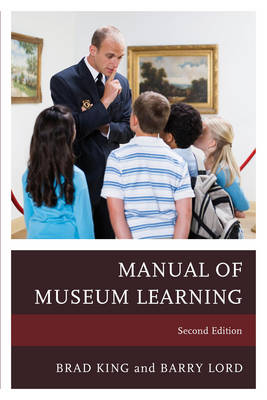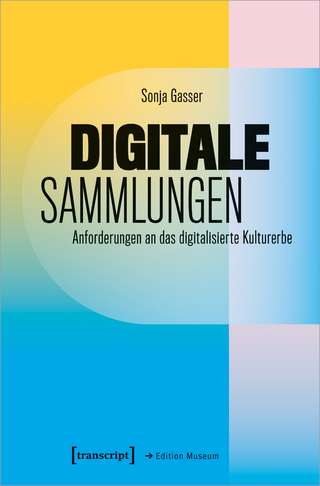
The Manual of Museum Learning
Rowman & Littlefield (Verlag)
978-1-4422-5846-4 (ISBN)
In this new edition of The Manual of Museum Learning, leading museum education professionals offer practical advice for creating successful learning experiences in museums and related institutions (such as galleries, zoos, and botanic gardens) that can attract and intrigue diverse audiences.
The original Manual of Museum Learning was published in 2007. The editors have totally rethought this new edition. This second edition focuses on the ways museum staffs (and the departments for which they work) can facilitate the experience in a way that capitalizes on their individual institutional strengths. The goal of this new edition is to provide museums with guidance in developing a strategic approach to their learning programs. There is a close connection between institution-wide strategic planning – where an institution decides what course and direction it will take for a five to seven-year period – and its approach to museum learning. One size does not fit all, and what each museum is (or aspires to be) will affect its individual approach.
Thus there are many routes for museums to take, many alternative ways for them to play this role. No one museum can be all things to all prospective learners; they will be better suited to some approaches than to others. This new edition identifies these approaches and enables museums to find the paths for which they are individually best suited, to help them identify their own unique approaches to facilitating museum learning. Each one’s mission and vision, its relationships with institutional and public stakeholders, local cultural and market factors, its individual collection and programmatic strengths, its financial position – all of these things matter. This second edition aims to help each museum find the right approach to learning for its unique situation by showing them the range of museum “personalities” in terms of their being learning institutions, what constitutes each type, and what the implications are of choosing one or another approach for a particular museum.
A major theme of the 2nd edition of The Manual of Museum Learning is museum as connector; the ways in which museums are facilitating self-directed learning by connecting people with resources. Not all will connect audiences with learning vehicles in the same way. If museum learning is affective learning, then it is the role of the museum to connect its visitors, program participants and others who benefit from its knowledge to the learning resources that best suit the institution’s strengths and matches them to the learning needs of the museum’s audiences. By connecting users to the resources they are most interested in, or which best suit each individual’s particular learning styles, museums are at their best when they empower individuals to design their own learning experience in ways that resonate best with each individual.
Brad King is a Vice President with Lord Cultural Resources in Toronto. He holds a PhD in History from the University of Toronto where he was a Doctoral Fellow of the Social Sciences and Humanities Research Council of Canada. Since joining Lord in 2000, Brad has led or contributed to a wide variety of museum and cultural planning projects and has been involved in some of the most interesting and ambitious projects of our time. He brings a wealth of international experience to his work, being recently active in the Arabian Gulf, South Asian and the Caribbean regions as well as in the United States and Canada. He is the author of chapters on collections analysis (The Manual of Museum Planning, 3rd ed.), on evolving museum-school relationships (The Manual of Museum Learning, 1st ed.) and is a frequent speaker at museum and academic conferences. The recently deceased Barry Lord, Co-President of Lord Cultural Resources, was internationally known as one of the world's leading museum planners. Based in Toronto but working globally, Barry brought over fifty years of experience in the management and planning of museums, galleries and historic sites to the hundreds of projects he has directed. With a B.A. in Philosophy from McMaster University followed by graduate work at Harvard University's Center for the Study of World Religions, Barry co-founded Lord Cultural Resources with his wife Gail Lord in 1981. Together they edited and wrote the world's first book on the subject, Planning Our Museums (1983) and three editions of The Manual of Museum Planning (1991, 1999 and 2012). Barry also co-authored The Cost of Collecting (1989) and The Manual of Museum Management (1997; 2nd edition, 2009), co-edited two editions of The Manual of Museum Exhibitions (2002 and 2014), and edited the first edition of The Manual of Museum Learning (2007). Barry co-authored Artists, Patrons, and the Public: Why Culture Changes with Gail in 2010. His most recent book, Art and Energy: How Culture Changes was published by the American Alliance of Museums in 2014.
Acknowledgments
List of Contributors
Prologue
Brad King
Section One: WHY
Planning Basics
1.Introduction
Brad King
2.Planning Strategically for Learning
Brad King
3.Planning for Informal Learning: Understanding and Simplifying the Interpretive Process
Jennifer Shepherd
Section Two: WHAT
A Framework for Museum Learning
Introduction
Brad King
4.Learning for Change
Ngaire Blankenberg
5.The Changing Role of the Curator
Sascha Priewe
6.Planning for Effective Learning Partnerships
Brad King
Case Study 6.1: Tine Seligmann, Project Learning Museum: collaboration between museums and the educational world, from project to concept
7.Museum Learning Outside the Museum
Ngaire Blankenberg
Case Study 7.1: Trish Savill, Campus Calgary/Open Minds – Moving the Classroom into the Community; doing together what we can’t do alone
Section Three: HOW
Transforming the Museum into a 21st Century Learning Institution
Introduction
Brad King
8. Managing Institutional Change
Introduction
Brad King
8.1Re-Visioning the Museum as a Learning Institution
Nannette V. Maciejunes and Cindy Meyers Foley
8.2Thinking About Operations
Charlie Walter
8.3Banishing the “Museum Position”: Training Front-Line Staff for Effective Learning
Kathleen Brown
8.4Facility Planning for Museum Learning
Heather Maximea
9.Planning for Audiences
Introduction
Brad King
9.1Adopting New Habits for Visitor-Centered Learning
Merilee Mostov
Case Study 9.1: Anne Madden, Engaging Audiences: Climate Change Learning at the Memorial University of Newfoundland Botanical Garden
9.2Childhood Learning in Museums
Brad King
Case Study 9.2 Candice Anderson, Cool Culture
9.3Access for Museum Learning
Katie Stringer
10.Planning Learning Programs
Introduction
Brad King
10.1Use of Collections in Museum Learning
Sascha Priewe
10.2The “Cultural Exhibition”: A Museum Model for Cultural Works-in-ProgressAndrea Sachdeva
10.3Learning From Interpretation
Katherine Molineux
Case Study 10.3: Genia Hesser, The North Dakota State Museum: A Thematic Approach to History Exhibits
10.4Tools and Technology for Museum Learning
Shailoh Phillips
11.Conclusion
Brad King
Postscript
Barry Lord
Glossary
Bibliography
Index
| Verlagsort | Lanham, MD |
|---|---|
| Sprache | englisch |
| Maße | 182 x 262 mm |
| Gewicht | 780 g |
| Themenwelt | Kunst / Musik / Theater |
| Geisteswissenschaften ► Geschichte ► Hilfswissenschaften | |
| Wirtschaft ► Betriebswirtschaft / Management | |
| ISBN-10 | 1-4422-5846-2 / 1442258462 |
| ISBN-13 | 978-1-4422-5846-4 / 9781442258464 |
| Zustand | Neuware |
| Haben Sie eine Frage zum Produkt? |
aus dem Bereich


